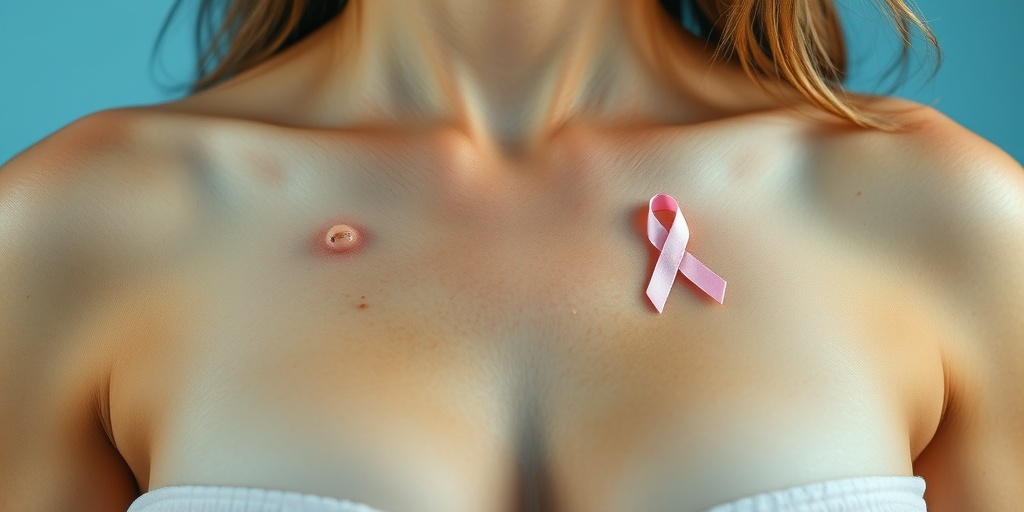What Is Breast Cancer?
Breast cancer is a type of cancer that develops from the breast tissue. It occurs when cells in the breast begin to grow uncontrollably, forming a tumor that can be felt as a lump or detected through imaging tests. While breast cancer primarily affects women, men can also develop this disease, although it is much rarer.
Types of Breast Cancer
There are several types of breast cancer, each with its own characteristics:
- Invasive Ductal Carcinoma (IDC): This is the most common type, starting in the milk ducts and invading nearby tissues.
- Invasive Lobular Carcinoma (ILC): This type begins in the lobules (milk-producing glands) and can spread to other parts of the body.
- Ductal Carcinoma In Situ (DCIS): A non-invasive cancer where cells inside the ducts have changed but have not spread.
- Lobular Carcinoma In Situ (LCIS): Although not considered a true breast cancer, it indicates an increased risk of developing breast cancer later.
Risk Factors for Breast Cancer
Understanding the risk factors can help in early detection and prevention. Some common risk factors include:
- Age: The risk increases as you get older.
- Family History: A family history of breast cancer can elevate your risk.
- Genetic Mutations: Certain inherited mutations, such as BRCA1 and BRCA2, significantly increase the risk.
- Hormonal Factors: Early menstruation, late menopause, and hormone replacement therapy can influence risk.
Breast Cancer Symptoms
Recognizing the symptoms of breast cancer early can be crucial for effective treatment. Here are some common signs to watch for:
Common Symptoms
- Lump or Mass: The most common symptom is a new lump or mass in the breast or underarm area.
- Changes in Breast Shape or Size: Any noticeable change in the shape or size of the breast should be evaluated.
- Skin Changes: Dimpling, puckering, or redness of the breast skin can be a sign of breast cancer.
- Nipple Changes: Any discharge from the nipple, especially if it is bloody or clear, should be checked by a healthcare professional.
When to See a Doctor
If you notice any of these symptoms, it’s important to consult a healthcare provider promptly. Early detection can significantly improve treatment outcomes. Regular screenings, such as mammograms, are also essential for women, especially those over 40 or with a family history of breast cancer.
Conclusion
Understanding breast cancer and its symptoms is vital for early detection and effective treatment. If you or someone you know is facing a breast cancer diagnosis, resources like Yesil Health AI (yesilhealth.com) can provide evidence-based health answers and support. Remember, being informed is the first step towards taking control of your health! 💖

Breast Cancer Risk Factors
Understanding the risk factors associated with breast cancer is crucial for early detection and prevention. While some factors are beyond our control, being aware of them can help individuals make informed lifestyle choices.
Genetic Factors
One of the most significant risk factors for breast cancer is genetics. Individuals with a family history of breast cancer, particularly those with mutations in the BRCA1 and BRCA2 genes, are at a higher risk. If you have close relatives who have been diagnosed with breast cancer, it may be beneficial to discuss genetic testing with your healthcare provider.
Age and Gender
Age is another critical factor; the risk of developing breast cancer increases as women age. Most cases are diagnosed in women over the age of 50. Additionally, while men can also develop breast cancer, it is significantly rarer, making gender a notable risk factor.
Hormonal Factors
Hormonal influences play a significant role in breast cancer risk. Women who began menstruating at an early age or went through menopause later than average may have an increased risk. Furthermore, those who have never had children or had their first child after the age of 30 may also be at a higher risk due to prolonged exposure to estrogen.
Lifestyle Choices
Certain lifestyle choices can also impact breast cancer risk:
- Alcohol Consumption: Studies suggest that consuming alcohol can increase the risk of breast cancer. Limiting alcohol intake may be a wise choice.
- Obesity: Being overweight or obese, particularly after menopause, is linked to a higher risk of breast cancer.
- Physical Activity: Regular exercise can help maintain a healthy weight and may lower the risk of breast cancer.
Radiation Exposure
Individuals who have undergone radiation therapy to the chest area, particularly during childhood or young adulthood, are at an increased risk of developing breast cancer later in life. It’s essential to discuss any past radiation exposure with your healthcare provider.
Environmental Factors
Emerging research suggests that environmental factors, such as exposure to certain chemicals and pollutants, may also contribute to breast cancer risk. While more studies are needed, being mindful of environmental health can be beneficial.
Breast Cancer Diagnosis
Early diagnosis of breast cancer significantly improves treatment outcomes. Understanding the diagnostic process can empower individuals to take charge of their health.
Self-Examination
Regular self-examinations are a vital first step in breast cancer detection. Women should familiarize themselves with the normal look and feel of their breasts to identify any changes. Look for:
- New lumps or masses
- Changes in breast shape or size
- Unusual discharge from the nipple
- Skin changes, such as dimpling or redness
Clinical Breast Exams
In addition to self-examinations, clinical breast exams performed by healthcare professionals are essential. These exams can help identify abnormalities that may not be noticeable during self-exams.
Imaging Tests
If a lump or abnormality is detected, further imaging tests may be recommended:
- Mammography: This X-ray of the breast is the most common screening tool for breast cancer. It can detect tumors that are too small to be felt.
- Ultrasound: Often used to further evaluate a suspicious area found on a mammogram, ultrasound can help distinguish between solid masses and fluid-filled cysts.
- Magnetic Resonance Imaging (MRI): An MRI may be used in certain cases, especially for women at high risk of breast cancer.
Biopsy
If imaging tests suggest the presence of cancer, a biopsy will be performed to confirm the diagnosis. During a biopsy, a small sample of breast tissue is removed and examined under a microscope. There are several types of biopsies, including:
- Fine-needle aspiration: A thin needle is used to extract tissue or fluid.
- Core needle biopsy: A larger needle removes a small cylinder of tissue.
- Surgical biopsy: A surgical procedure to remove a portion or all of a lump for examination.
Understanding these risk factors and the diagnostic process can empower individuals to take proactive steps in managing their breast health. Regular screenings and being aware of changes in your body are key components in the fight against breast cancer. 💖

Breast Cancer Staging
Understanding the stage of breast cancer is crucial for determining the most effective treatment options. Breast cancer staging involves assessing the size of the tumor, whether it has spread to lymph nodes, and if it has metastasized to other parts of the body. The most commonly used system for staging breast cancer is the AJCC (American Joint Committee on Cancer) system, which categorizes the disease into stages ranging from 0 to IV.
What Are the Stages of Breast Cancer?
- Stage 0: Also known as ductal carcinoma in situ (DCIS), this stage indicates that abnormal cells are present in the lining of the breast duct but have not invaded surrounding tissues.
- Stage I: The cancer is invasive but small (up to 2 cm) and has not spread to lymph nodes.
- Stage II: The tumor is larger (2-5 cm) or has spread to nearby lymph nodes.
- Stage III: This stage indicates a larger tumor that may have spread to multiple lymph nodes or nearby tissues.
- Stage IV: The cancer has metastasized to distant organs, such as the bones, liver, or lungs.
Each stage of breast cancer requires a tailored approach to treatment, making accurate staging essential for effective management. Doctors often use imaging tests like mammograms, ultrasounds, and MRIs, along with biopsies, to determine the stage of the cancer.
Importance of Staging in Treatment Planning
Staging not only helps in understanding the extent of the disease but also plays a significant role in breast cancer treatment guidelines. For instance, early-stage cancers (Stage 0 and I) may be treated with less aggressive methods, while advanced stages (Stage III and IV) often require more intensive therapies. Knowing the stage can also help patients and healthcare providers discuss prognosis and potential outcomes more effectively.
Breast Cancer Treatment Types
Once the cancer is staged, the next step is to explore the various breast cancer treatment options. Treatment plans are often personalized based on the type and stage of cancer, as well as the patient’s overall health and preferences. Here are the primary treatment types:
Surgery
Surgery is often the first line of treatment for breast cancer. There are two main types:
- Lumpectomy: This involves removing the tumor and a small margin of surrounding tissue. It is often followed by radiation therapy.
- Mastectomy: This procedure involves removing one or both breasts, either partially or completely, depending on the extent of the cancer.
Radiation Therapy
Radiation therapy uses high-energy waves to target and kill cancer cells. It is commonly used after surgery to eliminate any remaining cancer cells in the breast or surrounding areas. This treatment can help reduce the risk of recurrence.
Chemotherapy
Chemotherapy involves using drugs to kill cancer cells or stop their growth. It can be administered before surgery (neoadjuvant therapy) to shrink tumors or after surgery (adjuvant therapy) to eliminate any remaining cancer cells. The specific drugs used will depend on the cancer’s characteristics and the patient’s health.
Hormonal Therapy
For cancers that are hormone receptor-positive, hormonal therapy can be an effective treatment. This therapy works by blocking the body’s natural hormones, such as estrogen, from supporting the growth of cancer cells. Common medications include tamoxifen and aromatase inhibitors.
Targeted Therapy
Targeted therapies are designed to specifically attack cancer cells while minimizing damage to normal cells. These treatments often focus on specific genetic markers or proteins found in certain types of breast cancer. For example, HER2-positive breast cancers may be treated with drugs like trastuzumab (Herceptin).
Immunotherapy
Immunotherapy is an emerging treatment that helps the body’s immune system recognize and fight cancer cells. While still being researched for breast cancer, it shows promise, particularly for triple-negative breast cancer.
Each treatment type has its own set of potential side effects and considerations, making it essential for patients to discuss their options thoroughly with their healthcare team. Understanding the various breast cancer treatment drugs and their implications can empower patients to make informed decisions about their care.

Breast Cancer Surgery Options
When it comes to breast cancer treatment, surgery is often a critical component of the overall management plan. The type of surgery recommended can vary based on several factors, including the stage of cancer, the size of the tumor, and the patient’s overall health. Here, we’ll explore the primary surgical options available for breast cancer patients.
1. Lumpectomy
A lumpectomy, also known as breast-conserving surgery, involves the removal of the tumor along with a small margin of surrounding healthy tissue. This option is typically recommended for patients with early-stage breast cancer. The benefits of a lumpectomy include:
- Preservation of breast tissue: Most of the breast remains intact, which can be important for body image.
- Shorter recovery time: Patients often experience a quicker recovery compared to more extensive surgeries.
- Effective treatment: Studies show that lumpectomy followed by radiation can be as effective as mastectomy for early-stage breast cancer.
2. Mastectomy
A mastectomy involves the removal of one or both breasts, depending on the extent of the cancer. There are several types of mastectomy:
- Partial mastectomy: Only a portion of the breast is removed.
- Total mastectomy: The entire breast is removed.
- Radical mastectomy: This involves the removal of the breast, underlying chest muscle, and nearby lymph nodes.
Mastectomy may be recommended for patients with:
- Large tumors relative to breast size
- Multiple tumors in the same breast
- Genetic predisposition to breast cancer (e.g., BRCA1 or BRCA2 mutations)
3. Sentinel Lymph Node Biopsy
This procedure is often performed alongside lumpectomy or mastectomy. It involves the removal of a limited number of lymph nodes to determine if cancer has spread. If cancer is found in these nodes, further treatment may be necessary.
4. Axillary Lymph Node Dissection
If cancer is detected in the sentinel lymph nodes, an axillary lymph node dissection may be performed. This involves removing additional lymph nodes from the underarm area to assess the extent of cancer spread.
5. Reconstruction Surgery
For those who undergo mastectomy, breast reconstruction is an option to restore the breast’s appearance. This can be done immediately after the mastectomy or at a later date. Options include:
- Implant-based reconstruction: Involves placing silicone or saline implants.
- Flap reconstruction: Uses tissue from another part of the body to create a new breast shape.
Breast Cancer Support and Resources
Facing a breast cancer diagnosis can be overwhelming, but numerous resources and support systems are available to help patients and their families navigate this challenging journey. Here are some valuable options:
1. Support Groups
Connecting with others who are experiencing similar challenges can provide emotional support and practical advice. Many organizations offer in-person and online support groups where patients can share their experiences and feelings.
2. Counseling Services
Professional counseling can be beneficial for patients and their families. Mental health professionals can help individuals cope with the emotional aspects of a cancer diagnosis, treatment, and recovery.
3. Educational Resources
Knowledge is power. Many organizations provide comprehensive information about breast cancer, treatment options, and coping strategies. Websites like the American Cancer Society and BreastCancer.org offer valuable resources.
4. Financial Assistance
Understanding the breast cancer treatment cost can be daunting. Various organizations offer financial assistance programs to help cover treatment expenses, medications, and other related costs. It’s essential to explore these options early in the treatment process.
5. Nutrition and Wellness Programs
Maintaining a healthy lifestyle during treatment can improve overall well-being. Many cancer centers offer nutrition and wellness programs tailored to the needs of breast cancer patients, focusing on diet, exercise, and holistic approaches to health.
6. Online Communities
Social media and online forums can be excellent platforms for finding support and sharing experiences. Websites like Reddit and Facebook have groups dedicated to breast cancer where individuals can connect and share resources.
In conclusion, understanding the breast cancer treatment options and available support resources is crucial for patients and their families. With the right information and support, navigating this journey can become a little easier. 💖

Frequently Asked Questions about Breast Cancer: Treatment
What are the common treatment options for breast cancer?
There are several treatment options available for breast cancer, including:
- Surgery
- Radiation therapy
- Chemotherapy
- Hormonal therapy
- Targeted therapy
How is breast cancer treatment determined by stage?
The treatment for breast cancer is often tailored based on the stage of the disease. Early-stage cancers may require less aggressive treatment, while advanced stages may involve a combination of therapies. It’s essential to consult with a healthcare provider to understand the best approach for your specific situation.
What is the average cost of breast cancer treatment?
The cost of breast cancer treatment can vary widely depending on the type of treatment, location, and healthcare provider. In general, treatments can range from thousands to tens of thousands of dollars. It’s advisable to check with your insurance provider and discuss financial options with your healthcare team.
Are there specific guidelines for breast cancer treatment?
Yes, there are established guidelines for breast cancer treatment that help healthcare providers determine the best course of action. These guidelines are based on the latest research and clinical trials and are regularly updated to reflect new findings.
What drugs are commonly used in breast cancer treatment?
Several drugs are used in the treatment of breast cancer, including:
- Tamoxifen
- Letrozole
- Trastuzumab
- Docetaxel
These medications may be used alone or in combination, depending on the specific characteristics of the cancer.
How long does breast cancer treatment typically last?
The treatment timeline for breast cancer can vary significantly based on the type and stage of cancer. Generally, treatment can last from a few weeks to several months, with follow-up care continuing for years. Your healthcare team will provide a personalized timeline based on your treatment plan.
Is there breast cancer treatment available in different languages?
Yes, many healthcare providers offer resources and information about breast cancer treatment in various languages, including Hindi. It’s important to communicate with your healthcare team about your language preferences to ensure you receive the best support.
What are the latest advancements in breast cancer treatment?
Research is ongoing, and there are always new advancements in breast cancer treatment. Innovations in targeted therapies, immunotherapies, and personalized medicine are improving outcomes for many patients. Staying informed through reputable sources and discussions with your healthcare provider can help you learn about the latest options.
How can I support a loved one undergoing breast cancer treatment?
Supporting a loved one during their breast cancer treatment can be incredibly valuable. Here are some ways to help:
- Be there to listen and provide emotional support.
- Help with daily tasks and errands.
- Encourage them to follow their treatment plan.
- Join them for medical appointments if they wish.
Remember, every person’s journey is unique, so ask them how you can best support them. 💖




